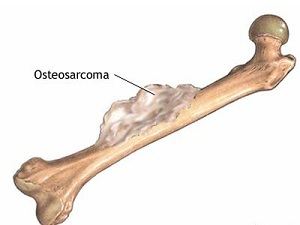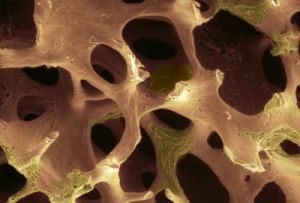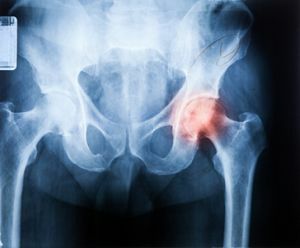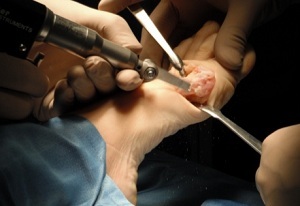 One type of cancer is bone cancer. This is a rare rare disease, which mostly affects adolescents and elderly people.
One type of cancer is bone cancer. This is a rare rare disease, which mostly affects adolescents and elderly people.
Bone oncology is diagnosed infrequently and makes 1% of all malignant tumors of .Unfortunately, although the disease is rare, but it is characterized by rapid development, metastases and severe symptoms, and also represents a significant danger to human health.
In recent years, thanks to the discoveries in the field of radiosurgery and the newest treatment methods, the prognosis regarding bone oncology is favorable. To date, there are several types of bone cancer.
The most common form is osteogenic sarcoma.
Contents of the article
- What is the peculiarity of this tumor?
- Localization of Education
- Degrees of Disease
- Symptoms of Disease
- Diagnostic Techniques
- Treatment - Complexities and Possibilities
- Prognosis Improves Year after Year
- Preventative Measures
What is the specificity of this tumor?
Osteosarcoma is a malignant disease that affects the bones, but just like many other tumors it can spread to nearby tissues.
In this case it is muscles, tendons, peripheral nerves. In addition, the disease can give metastases to neighboring organs. Most often these are lungs, less frequently bones, brain and others.
A characteristic feature of osteogenic sarcoma is that the tumor cells begin to produce an osteoid( immature bone tissue).
In this regard, although there is an inert substance, but it lacks calcium. The causes of the development of the disease are not fully understood, but still, the main risk factors are called: rapid growth, various injuries and bone diseases, X-ray irradiation.
Sometimes the disease affects the elderly. About 10% of patients with an ailment are people over 60 years old. There is also a disease with  of some genetic abnormalities. Tumors of bones are much more common in men than in women.
of some genetic abnormalities. Tumors of bones are much more common in men than in women.
For one million people in the world, 2-3 cases of osteosarcoma are diagnosed every year. In the US, about 900 patients are registered annually for these diseases, in Russia this amount is slightly higher.
Despite the insidiousness of the disease, with timely treatment and competent treatment, the chances of recovery are very high.
Localization of education
For the most part, the disease affects long tubular bones, so it often occurs in the knee area. Bone cancer in children and adolescents, in most cases, is found near the knee joint.
Also on the frequency of localization of the disease one of the first places is occupied by the upper humeral section. Nevertheless, the lower limbs are 5 times more often affected than the upper limbs.
Moreover, osteogenic sarcoma can develop in the field:
- of the pelvis;
- of the skull;
- of the jaw;
- of the thigh;
- ribs;
- and others.
Skull bones are seldom affected, mostly such a disease can be diagnosed in the elderly.
Degrees of disease
Three degrees of the disease are distinguished: low and high malignancy and stage of metastasized tumor.
A low degree can extend beyond the periosteum, there is no metastasis, virtually no symptoms.
Osteogenic sarcoma of a high degree of malignancy occurs most often, it is characterized by severe symptoms, there are no metastases.
The most common subtypes are osteoblastic, chondroblastic, and fibroblastic. The stage of the disease, which has metastases, is characterized by the destruction of bones and other organs.
 For the most part, the disease metastasizes into the lungs and can also affect other bones and organs. This is the most severe degree of ailment, recorded in every fifth patient with osteogenic sarcoma.
For the most part, the disease metastasizes into the lungs and can also affect other bones and organs. This is the most severe degree of ailment, recorded in every fifth patient with osteogenic sarcoma.
For the most part, the degree of malignancy predetermines the prognosis of the disease. For example, after complete elimination of a tumor of low degree, the result is quite favorable.
High degree of disease necessarily requires surgery and chemotherapy sessions. The prognosis for the stage with metastases is not entirely comforting.
Symptoms of the disease
At the initial stage of the disease, symptoms do not practically manifest, only when the disease begins to progress there are complaints of the patient to the pain over the affected joint, which becomes more noticeable during physical exertion and at night can also appear lameness. The pain is dull, gradually increasing.
With the development of the disease process, a tumor develops, which eventually increases, joint swelling arises, and the pain becomes even worse.
In rare cases, a fracture of the femur or other bones may occur. In later stages, there are signs of a general nature: fatigue, sleep disturbance, fever, etc.
As the disease is very active and characterized by aggressive growth, metastases occur in nearby organs.
Diagnostic techniques
The primary diagnosis of the disease is based on the results of laboratory and instrumental examinations. The final conclusion is made with the help of X-ray images, on which the focus of bone destruction is visible.
If a tumor is detected, a biopsy is also performed. To more accurately study the tumor and surrounding tissue allows computed tomography, thanks to this it is possible to obtain additional information about the bone marrow cavity of the bone and to detect metastases in time.
In addition, osteoscintigraphy is often used to detect metastases. In some cases, positron emission tomography is also used to accurately diagnose the disease.

On the photo of the femur osteosarcoma
Treatment - the complexities and possibilities of
In the recent past, the treatment of this disease was limited to amputation of the extremities. To date, with the arrival of the newest methods of treatment, more gentle methods have appeared.
The aim of such therapy is to completely remove the tumor and inhibit the development of cancer cells. In cases where the bone is removed along with a number of existing tissues, it is replaced with an artificial prosthesis or bone implant.
For children and adolescents, it is recommended to use endoprostheses, they enable them to increase their length as the child grows.
In addition, it is widely used and the rapid removal of large metastases, especially in the lungs. 
Because osteosarcoma progresses rapidly, in addition to the removal of the tumor, it is necessary to perform chemotherapy, which is also used as a preoperative period, and after surgery. It helps to destroy cancer cells and increase the chances of the patient recovering.
Sufficiently effective agents among chemotherapy drugs are: high-dose methotrexate, etoposide, ifosfamide. If it is not possible to remove the tumor, radiotherapy is used, although this is not always effective.
In addition to these methods of treatment, biotherapy is widely practiced that stimulates the immune system and helps the body fight cancer cells.
The prognosis is improving every year
In connection with the emergence of new improved therapies for osteogenic sarcoma, the results of treatment have improved significantly in recent years.
According to statistics, about 60-70% of patients who do not have metastases are recovering and have good chances of recovery. The localized forms are the most productive treatment, as they differ in their sensitivity to chemotherapy.
Certainly, the prognosis of the disease largely depends on the location of the tumor, the stage of the disease, and also on the competent surgical intervention and the general condition of the patient.
Preventive measures
There are no specific preventive measures in terms of this disease. But still, experts recommend regular scheduled examinations, and in case of detection of pathology, start treatment on time.
One way or another, it is necessary to strengthen the immune system, avoid excessive physical exertion and bone injuries, take zinc and phosphorus, which is so necessary for bone health.
Although a bone tumor is a serious enough disease, one should not be depressed. If the diagnosis is set in time, then the competent treatment of the doctor and the observance of all the necessary measures on the part of the patient significantly increase the chances of recovery.



